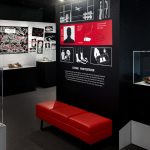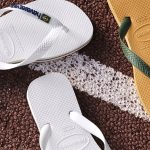The Forzani Group’s fourth quarter total revenues were $274.3 million, a decrease of 2.3% from the prior year. Corporate store revenues, at $229.5 million, were 4.1% below last year’s revenues of $239.2 million. Corporate comparable stores sales for the fourth quarter declined by 7.7%, driven by poor ski and snowboard sales due to the unseasonable weather. Corporate comparable store sales of ski and snowboard equipment, which represents a material proportion of the quarter’s total volume, were down 14.1%. Corporate comparable store winter outerwear and accessory sales fared better, despite the weather, down only 3.2% for the quarter. Licensed clothing, typically a strong seller in the quarter, was off 39.5% due primarily to the NHL lockout. These categories, combined, accounted for the majority of the decline in corporate comparable store sales.
Wholesale sales for the quarter were $44.8 million, up 7.4% from the prior year, driven by strong product sales into the Company’s franchise network and by the volume contributed by Gen-X, a wholesale company that was acquired in the first quarter of the year. Franchise comparable store sales, predominantly based in Quebec, were up 7.1% for the quarter.
The Company’s margins for the quarter were 37.4% down 140 basis points from the prior year mark of 38.8%. This was principally due to the shift in the sales mix between the higher margin corporate store retail sales and wholesale sales that generate lower margins. Corporate store margins held up well despite increased promotional activity in the ski, snowboard and outerwear categories to end up only 55 basis points behind last year’s margins.
Corporate store operating expenses were $53.1 million, up less than $200,000 from the prior year. On a comparable store basis, corporate store operating expenses were 4.5% lower than the prior year. General and administrative expenses were also below prior year levels.
Net earnings for the quarter were $13.0 million or 4.7% of revenues versus $16.1 million or 5.7% the year earlier. Earnings per share were $0.40 versus $0.50(1) in the prior year.
For the year, total revenues were $985.1 million, a 1.8% increase from the prior year level of $968.1 million. Corporate store revenues were $718.8 million, down 1.9% from last year’s number of $732.9 million. Corporate comparable store sales for the year declined 5.1%, while the franchise division comparable store sales increased 2.2% for the year. Combined company comparable store sales for the year decreased 2.6%.
Wholesale sales for the year were $266.2 million, up 13.2% from the prior year, driven primarily by the volume generated by the Gen-X acquisition.
Store operating expenses, at $189.8 million, were 26.4% of corporate revenues versus $186.7 million or 25.5% a year earlier. On a comparable store basis, store-operating expenses were down 1.9% versus the prior year. General and administrative costs were $66.5 million or 6.8% of revenues versus $65.1 million or 6.7% in the prior year.
Earnings before interest, taxes and amortization (“EBITDA”) were $77.6 million, down $3.7 million or 4.6% from the prior year. Net earnings were $22.9 million or $0.70 per share, $0.74 exclusive of the investment write-down taken in Q2 relating to Huffy Corporation, compared to $28.1 million or $0.87(1) per share a year earlier.
The Company’s financial position remains strong with a working capital surplus, at year-end, of $113.4 million versus $111.1 million. Cash flow generated from operations, before changes in non-cash working capital elements, was static at $54.3 million.
Despite the difficult sales climate for ski and snowboard equipment, as well as related accessories and outerwear, brought about by a lack of snow in the mountains in B.C. and Alberta during critical parts of the selling season, timely markdowns coupled with a conservative purchasing stance enabled the Company to manage its inventories extremely well. Comparable store inventories, including quantities held in the company’s distribution centre, declined 4.0% versus a year ago.
On an overall basis, inventories again declined in fiscal 05 by 1.7% despite the addition of 15 new corporate stores.
“We are disappointed with the results of the fourth quarter and, by extension, the year.” stated Chief Executive Officer, Bob Sartor. “This is the second difficult year in a row for our Company. The reasons for these difficulties are obvious to us, as are the solutions to overcome them. A massive focus on reenergizing corporate comp sales is required, which is addressed below. Our athletic and casual sales have been negatively impacted for two consecutive years by the emergence of new, predominantly U.S.retail entrants into our market and by a general decline in the attractiveness of athletic clothing, as everyday wear, to our target consumer market. The solution to this was to completely re-work our clothing product mix and to carefully manage our existing inventories down, which we have now done.
The Ontario market has proven to be particularly challenging in the past year as several players found themselves over inventoried. As a result, acute price pressure during prime selling periods occurred, depressing margins and sales in our Ontario corporate store base. Again, our response to this was obvious. We did not shy away from the fray only to, in our view, surrender market share and prolong the difficulties in this market. Rather, we vigorously defended our current market share and stepped up our promotional activity. As a result, during the past year, one national competitor with a strong Ontario base began a program of selected store closures, a regional, Ontario-based chain closed its doors entirely disbursing approximately $50 million of annual sales in the marketplace, and most recently, during the first quarter of this year, we acquired National Sports, a strong Ontario retailer with a good niche position in hockey and team sports in that market providing the C
ompany with over $80 million in new volume.
As for the softness in ski, snowboard and outerwear this year, we cannot control the temperatures or the amount of snowfall that we receive, nor its timing. What we can control is our purchasing of these categories, the timing of our markdowns to minimize negative impacts to our Company and our inventory position, which we did.”
Added Bill Gregson, President and Chief Operating Officer, “The focus on reenergizing corporate comps is the single biggest factor in improving our financial performance. This initiative will begin in earnest this spring and includes:
- To face-lift 60 Sport Cheks with the new lighting and paint colours, so well received in the latest Sport Cheks. The lighting is energy efficient, but more importantly, combined with a brighter paint palette, will greatly brighten the stores providing a much-improved shopping experience.
- A clothing product-mix assortment change. A great reduction in private label, lifestyle product and commodity oriented athletic branded product. This product did not compete well with the product offered by U.S. based, vertically integrated clothing companies. We will add into our stores a much bigger assortment of branded lifestyle/athletic product from brands such as Burton, Vans, Oakley, ONeill and Puma. This was tested during the 2004 holiday season and did very well.
We will create an outdoor sportswear department featuring Columbia and, by fall, The North Face in all stores.
We will continue to expand technical branded athletic wear with a greater assortment and launch a kids program.
- An increase in average price points. With our inventories now in much better condition in all categories, especially clothing, and with a greater purchase of statement and elite product in footwear, outerwear and hardgoods, we expect to see average price points increase.
- Continued growth in underdeveloped categories such as bike, golf and fitness and for spring, the introduction of a camping program.
- A return to radio and newspaper advertising for Sport Chek this year to support selected flyers. We did no radio or newspaper last year. The branded TV campaign “Power of Sport” will remain and be expanded.
- A company-wide commitment to improved basic stock replenishment, to ensure that we are in stock on the key items everyday, every store.
The National Sports Acquisition:
The Company’s acquisition of National Sports during the first quarter of fiscal 2006 provided it with a strong regional player that has a great hockey and team sports positioning. Store overlap is not significant and overall procurement synergies will be slightly better than originally anticipated. While much speculation has surfaced regarding the expansion of National Sports outside of Ontario, no decisions have been taken by management in this regard. During the coming fiscal year, in any event, management will be focused on consolidating the market share gains achieved in Ontario and achieving the synergies available, as a result of the acquisition. The acquisition of National Sports and the additional volume that competitors store closures will likely add to the Company’s existing store base, will push market share in Ontario above 17% from its current base of 12%, a 42% increase in market share.
In order to ensure that the gains in market share made in Ontario this year translate quickly into increased profitability in that market, the Company recently announced the addition of Douglas Hayes, as President of National Sports and as a Senior Vice President of The Forzani Group Ltd. “Doug joins our Company with an illustrious career to date in the sporting goods industry.” stated Bob Sartor, CEO of the Company. “Doug comes to us most recently from Callaway Golf, where he managed the Callaway, Hogan and Top Flite brands. Prior to that, Doug was President of adidas Canada and managed the adidas, Salomon and Taylor Made brands. In addition to working directly with Stephen Clements, the Chief Merchandising Officer, as well as the rest of the talented management team at National Sports, Doug will work closely with the management team in Calgary to ensure banner and brand positioning and promotional programs in Ontario are designed to maximize growth and store contribution. D
oug will report directly to Bill Gregson, President and Chief Operating Officer of FGL.”
Long-Term Perspective
During the past year, the Company’s continued pursuit of its long-term strategic objectives have been over shadowed by current operating performance. However, fiscal 2005 was particularly productive from a strategic point of view, with the following key “building block” occurrences:
- The acquisition of Gen-X Sports
The acquisition of a great close-out and licensed brand business, led by an outstanding management team, expanded FGL’s wholesale reach outside of Canada while strengthening its ability to compete within Canada through the addition of more close out product to the mix.
- The acquisition of Nevada Bob’s
The addition of the Nevada Bob’s specialty golf banner fulfilled a desire to move into the high-end golf business and generate new wholesale revenues for the Company.
- The acquisition of the Hespeler Hockey brand
Hockey is a core category for the Company, and the addition of Hespeler Hockey in addition to the Victoriaville (“VIC”) brand acquired, in the prior year, will improve the profitability of the category in our corporate and franchise stores, in addition to providing new sales volume for FGL outside of Canada from these brands.
- The doubling of our warehousing capacity
The move, in June of last year, of the Company’s warehousing operation into a 475,000 square foot distribution facility, along with the introduction of state-of-the-art materials handling technology and equipment, more than doubled the Company’s capacity for product distribution. This will provide a platform for future acquisitions and current business growth.
- The introduction of new merchandising/buying system
The Company converted its existing merchandising systems for its Sport Chek and Coast Mountain Sports stores to new technology, which will improve buying, product flow and inventory management and turns, as well as markdowns.
The Company’s strategic plan calls for a strong Canadian retail company as the core, augmented and enhanced by an appropriate level of vertical product integration and the development of new wholesaling sources, both within and outside of Canada. This will ultimately result in a company with more stable earnings and cash flow and reduced volatility to seasonal and cyclical issues. This is what has been pursued during these past two years and what will continue to be pursued.
“We are very cognizant of the detrimental effect that current earnings performance has and continues to have on the Company’s stock price.” Stated Bob Sartor, CEO. “And, we continue to work very hard to correct that, at all levels of our Company. “















